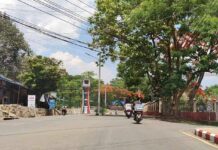Kantarawaddy Times
In the western part of Hpruso Township, Karenni State, both local residents and internally displaced persons (IDPs) have been increasingly searching for wild orchid plants and selling back them during the summer season, according to a trader.
“Since there are no jobs for them, they collect and sell these plants (Orchids). Even if it’s not much, they can earn around 10,000 to 20,000 kyats a day. If there are buyers, they will go out to search,” the trader explained.
Due to the scarcity of job opportunities, some villagers have turned to collecting wild orchids to sell. The income that they earn is then used to buy basic necessities like cooking oil, salt, and seasoning powder. This helps them to manage their household expenses.
Because there are various types of wild orchid, the price depends on the species. In the forests and hills of western Hpruso, the commonly found orchids are sold at different rates. The market prices are Purple Orchid (local name) with 3,000 kyats per viss, Eight-petal Orchid with 2,500 kyats per viss, ‘Phyu Su Pan’ or White Thorn Orchid with 2,000 kyats per viss, ‘Thit Kyar Lone Pan’ or Thick Stem Orchid with 1,000 kyats per viss, ‘Kyoute Pan’ or Stone Orchid with 10,000 kyats per viss, and ‘Thet Kel Pan’ with 10,000 kyats per viss.
Among them, ‘Thazin’ Orchids are the most expensive one, with a market price between 20,000 and 30,000 kyats per viss.
During slash-and-burn farming seasons, villagers often come across wild orchids, making this period peak time for orchid sales. A trader noted that most of the orchids sold are common local varieties while ‘Thazin’ Orchids are rarer.
“Right now, Thazin Orchids are rare. Most of what we see are the ordinary wild orchids selling for 2,000 or 3,000 kyats. Those are very common. Thazin Orchids are still quite rare,” said the trader.
In addition to selling wild orchids, locals in western Hpruso also sell other forest products, such as cinnamons, turtle shells, and bear biles obtained from forest hunting.




